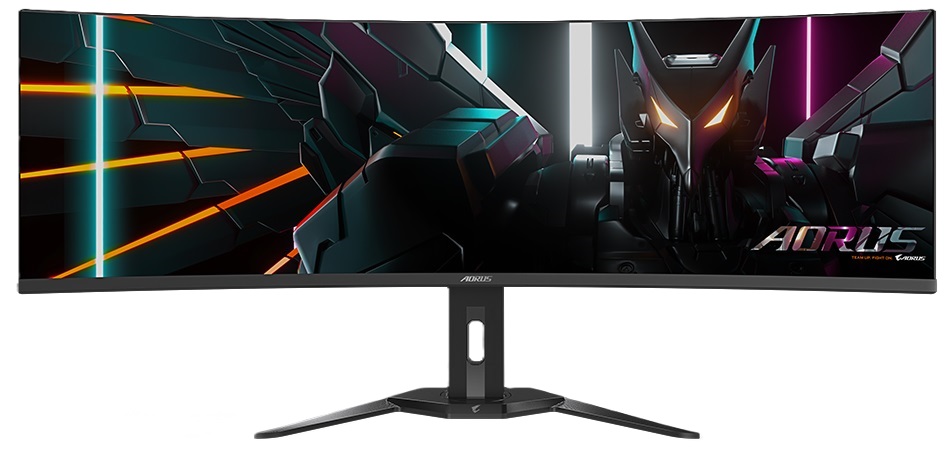Gigabyte AORUS CO49DQ 144Hz QD-OLED ultrawide
As an Amazon Associate I earn from qualifying purchases made using the “Buy” button at the bottom of this post. Where possible, you'll be redirected to your nearest store. Further information on supporting our work.The rich contrast, colour experience and responsiveness of OLED technology can be very attractive in a gaming monitor. The Gigabyte AORUS CO49DQ is designed with immersive gameplay in mind, with the large screen also marketed for ‘productivity’ (though we’d advise caution if this is your main use due to burn-in potential). The monitor has a sharp-angled stand with slim dual-stage bezels, including a slim panel border flush with the rest of the screen and thin hard plastic outer part. As common for OLED models an ‘active area’ is also present around the image for pixel shifting, one of the ‘OLED Care protection’ image retention mitigation measures. The OSD (On Screen Display) is controlled by a joystick facing down beneath the central area of the bottom bezel.
A 48.9″ Samsung QD-OLED (Quantum Dot OLED) panel is used, with 1800R (moderate) curve and 5120 x 1440 resolution (32:9 ultrawide). This is like having 2 x 27″ 16:9 QHD monitors side by side without bezels in the way, in terms of size and pixel density. The panel is described as ‘non-glare’ – we expect this to be the usual glossy anti-reflective screen surface seen on QD-OLEDs. A 144Hz refresh rate is supported alongside Adaptive-Sync, allowing technologies such as Nvidia ‘G-SYNC Compatible’ and AMD FreeSync to be used with assumed 48 – 144Hz VRR range plus LFC. HDMI 2.1 VRR should also be supported. A 1.5m:1 static contrast ratio is specified as well as 10-bit colour support and 178°/178° viewing angles – though OLED panels like this are far stronger than LCDs with similar specifications in that respect. The monitor is ‘flicker-free’ with 250 cd/m² (1000 cd/m² HDR peak at 3% APL) typical maximum luminance and 99% DCI-P3 colour gamut specified. A factory-calibrated sRGB emulation mode is also included. The monitor is VESA DisplayHDR True Black 400 specified using the appropriate HDR setting with limited brightness.
A 0.03ms grey to grey response time is specified, with the technology known to be exceptionally strong in that respect despite this exact figure being misleading. The stand attaches to the screen centrally with a quick-release mechanism allowing easy removal, revealing provision for 100 x 100mm VESA mounting. The screen offers tilt and swivel as the only ergonomic flexibilities. The ports face downwards and include; AC power input, a 3.5mm headphone jack, 2 HDMI 2.1 ports, DP 1.4 (with DSC and HBR3), USB-C (18W PD, DP Alt Mode, upstream data), USB 3.0 Type-B upstream and 2 USB 3.0 downstream ports. KVM is supported for easy peripheral sharing and display switching between 2 systems, with PiP/PbP also supported. The monitor includes 2 x 5W speakers for basic sound output.

Further details can be found on the manufacturer’s website. Details on price and availability still to come.


